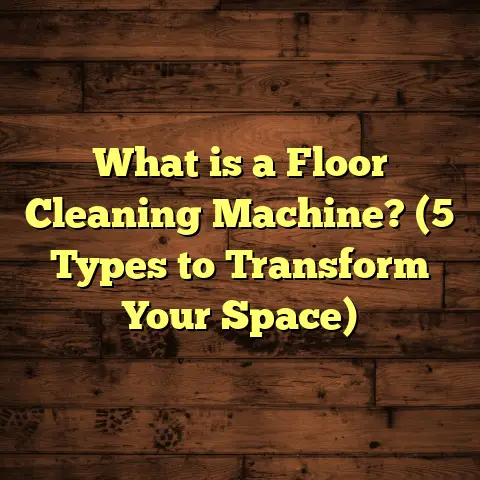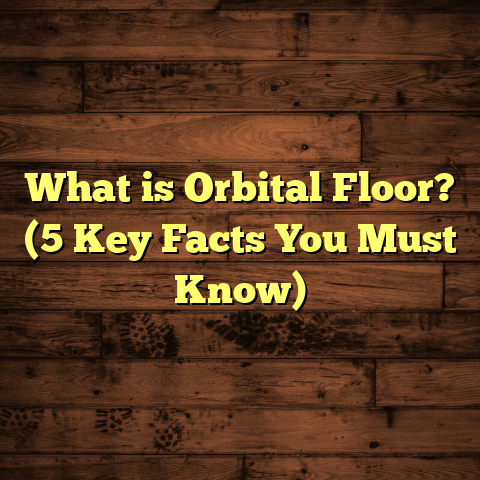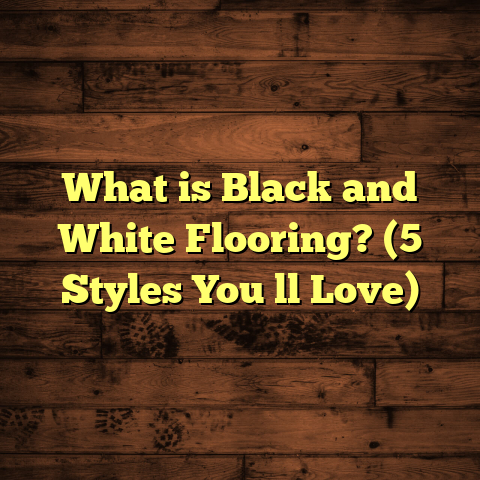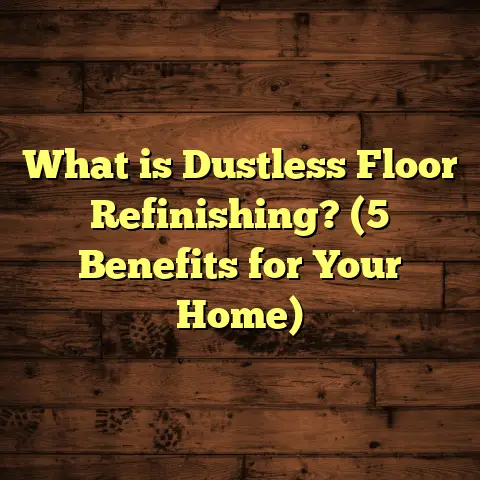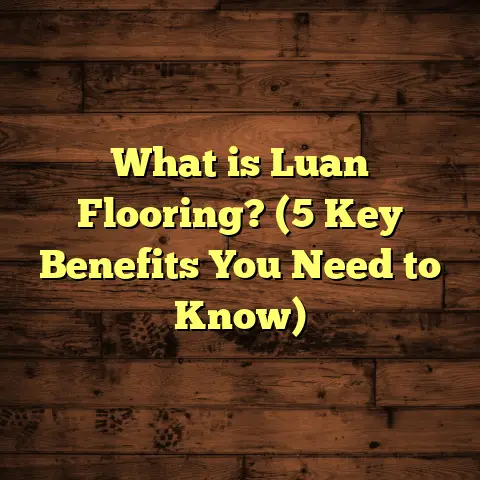What is Vinyl Plank Flooring? (5 Benefits You Can’t Ignore)
Have you ever stood in a store aisle, staring at flooring options, wondering which one can really handle the chaos of daily life at home without breaking the bank or looking cheap? I’ve been there more times than I can count. When I first started working as a flooring contractor, vinyl plank flooring wasn’t on my radar. But after installing it in several homes and seeing the results firsthand, I realized it’s a game-changer. So, what exactly is vinyl plank flooring, and why do so many homeowners and contractors swear by it? Let me share what I’ve learned.
What is Vinyl Plank Flooring?
Vinyl plank flooring is a type of resilient flooring designed to mimic the look and feel of hardwood planks. Unlike traditional vinyl sheets, vinyl planks come in individual pieces that resemble wood boards, usually measuring about 6 to 9 inches wide and 36 to 48 inches long. These planks are made from layers of polyvinyl chloride (PVC) and other compounds that give them durability, water resistance, and flexibility.
The surface layer typically features a photographic print of wood grain patterns, protected by a clear wear layer that resists scratches and stains. The backing layer provides stability and helps with moisture resistance. Many vinyl plank products also have an attached underlayment for sound absorption and comfort underfoot.
What makes vinyl plank flooring stand out is this combination of realistic appearance and practical performance. It can be installed using click-lock systems, glue-down methods, or loose lay options depending on the product and subfloor conditions. This versatility makes it accessible for both DIYers and professional installers like me.
How Vinyl Plank Flooring is Made
Understanding the manufacturing process gives you better insight into why vinyl plank flooring performs so well. The core of most vinyl planks is composed of PVC mixed with stabilizers and plasticizers that enhance flexibility and toughness. This core can vary—some brands offer rigid cores made with materials like stone plastic composite (SPC) or wood plastic composite (WPC) for added strength and dimensional stability.
On top of this core sits the printed design layer—the part that replicates wood grain patterns with high-resolution photography. This layer has improved a lot over the years; early versions looked artificial and flat, but now the prints are so detailed they fool many people into thinking they’re real wood.
The wear layer is a transparent coating made from urethane or aluminum oxide that protects the floor from scratches, stains, and fading caused by sunlight exposure. Thickness varies by product, which affects durability. Underneath the core is typically a backing layer that adds strength and moisture resistance.
Types of Vinyl Plank Flooring
There are generally three types of vinyl plank flooring based on installation style:
- Rigid Core Vinyl Plank: These have a solid core made from SPC or WPC. They’re more stable and resistant to dents or warping. Many feature an attached underlayment.
- Flexible Vinyl Plank: These are thinner and bendable. They’re usually glued down or loose laid. They’re less expensive but not as durable.
- Luxury Vinyl Plank (LVP): This term often refers to premium vinyl plank products with enhanced visuals, thicker wear layers, and better overall quality.
My Experience Installing Vinyl Plank Floors
When I first installed vinyl plank flooring in a client’s kitchen, I was skeptical about how it would hold up in such a high-traffic, moisture-prone area. Fast forward two years, and their floor still looks fantastic with no warping or peeling. The ease of cleaning and resilience against spills impressed me more than I expected.
One particular job involved a family with three kids and two dogs—hardly an environment gentle on floors. They wanted something durable but didn’t want to sacrifice style. We went with rigid core LVP in a medium oak finish with textured embossing for a natural feel. After nearly five years, the floor still looks great despite all the running, jumping, and occasional messes.
I’ve also noticed that clients appreciate how vinyl plank flooring can transform spaces visually without the hefty price tag of hardwood. For many families, it offers a perfect balance between style and function.
Benefit 1: Durability That Handles Everyday Life
One question I get asked often is: “Will vinyl plank flooring last?” The answer? Absolutely. Vinyl planks are built tough. Thanks to the wear layer I mentioned earlier, these floors resist scratches from pets’ claws, dents from dropped objects, and stains from spills.
Some stats to consider: According to a report by the Resilient Floor Covering Institute (RFCI), vinyl plank flooring has seen a steady increase in market share partly because of its durability compared to other flooring types. The wear layers range from 6 mil (0.15 mm) for light residential use to 40 mil (1 mm) for heavy commercial use.
A thicker wear layer means better protection against damage. For residential spaces, I recommend at least 12 mil thickness—this is where you get good resistance without overspending.
In one case study I reviewed from a home improvement firm, vinyl plank floors installed in rental units showed less wear after three years compared to laminate or engineered hardwood floors. Tenants appreciated the floors’ resistance to moisture and damage, reducing maintenance headaches for landlords.
Scratch Resistance
If you have pets like I do, you know how quickly claws can damage floors. Vinyl plank floors handle this surprisingly well. My dog’s nails have scratched hardwood floors before, but barely left marks on vinyl planks after years of use.
The wear layer contains urethane or aluminum oxide crystals that prevent surface abrasions. Some manufacturers even add extra scratch-resistant coatings specifically for pet owners.
Impact Resistance
Vinyl planks flex slightly under impact instead of cracking or chipping like wood or tile can. This flexibility helps prevent dents caused by heavy furniture or accidental drops.
I remember when a client dropped a cast-iron skillet on their vinyl plank kitchen floor—no damage at all. With hardwood, that might have meant an expensive repair or replacement.
Stain Resistance
Spills happen daily—coffee, wine, juice—and vinyl plank flooring makes cleanup easy. The surface doesn’t absorb liquids like untreated wood or carpet fibers do.
Many manufacturers treat their wear layers with stain-resistant finishes that repel spills quickly before they seep in.
Benefit 2: Water Resistance That Keeps Your Home Safe
Have you ever spilled water on your floor and panicked about damage? Vinyl plank flooring handles moisture much better than wood or laminate. Its PVC core doesn’t absorb water, making it ideal for kitchens, bathrooms, basements, or laundry rooms.
Some vinyl planks are even fully waterproof, meaning you can clean them with a mop or withstand pet accidents without worry. This feature reduces the risk of warping or buckling that wood floors face in damp conditions.
Water damage is one of the main causes of flooring failure in homes. Hardwood swells and warps when exposed to moisture beyond a small tolerance level (usually around 12% humidity). Laminate flooring fares better but can delaminate when water seeps into seams.
Vinyl plank flooring’s waterproof nature comes from its synthetic PVC composition combined with tight locking mechanisms that prevent water infiltration between planks.
Case Study: Flooded Laundry Room
A friend of mine had an unexpected washing machine leak that flooded their laundry room overnight. Their home had vinyl plank flooring installed just six months prior. Despite standing water for several hours, there was zero damage to the floor.
Contrast that with neighbors who had hardwood or laminate floors in similar situations—they faced costly repairs due to swelling or mold growth beneath flooring layers.
Mold Resistance
Because vinyl planks don’t absorb water, they don’t support mold growth like organic materials do. This makes them healthier for indoor air quality—especially important for homes with allergies or respiratory issues.
Benefit 3: Easy Installation Saves Time and Money
If you’re thinking about installing new floors yourself or want to avoid expensive labor costs, vinyl plank flooring is worth considering. Many products come with click-lock edges that snap together quickly without glue or nails.
I’ve installed click-lock vinyl planks in less than half the time it takes to lay hardwood or tile. This speed means less disruption at home and reduced installation fees if you hire a pro.
For example, a typical living room of 300 square feet might take two days for hardwood installation but only one day for vinyl plank flooring with click-lock systems when done by professionals.
You can also install vinyl planks over existing hard floors like tile or concrete, which cuts down on prep work. However, surface must be clean and level for best results.
DIY-Friendly
Many homeowners have successfully installed vinyl plank floors themselves because the process is straightforward compared to other types requiring subfloor sanding or complicated adhesives.
I once helped a couple who wanted to refresh their basement floor without hiring contractors. We picked rigid core LVP with click installation; they managed to complete the project over a weekend with minimal mistakes.
Glue-Down vs Click-Lock vs Loose Lay
- Glue-Down: Requires adhesive application; offers solid footing but takes longer.
- Click-Lock: Planks snap together; fastest method; easy replacement.
- Loose Lay: Heavier planks held by friction; good for temporary setups; fast removal if needed.
Choosing which method depends on your subfloor type, room usage, budget, and personal skill level.
Benefit 4: Affordable Style That Doesn’t Compromise Quality
Vinyl plank flooring offers a wide variety of designs that mimic everything from oak to exotic woods at a fraction of the cost. When clients see samples side-by-side with real hardwood, they’re often surprised by how close the resemblance is.
On average, vinyl plank flooring costs between $2 to $7 per square foot depending on quality and brand. Compare that to hardwood’s $8 to $15 per square foot price range — the savings add up quickly over large areas.
Design Variety
There’s almost no limit when it comes to styles available in vinyl planks today:
- Wood grains: From rustic farmhouse pine to sleek modern walnut.
- Textures: Embossed surfaces replicate natural knots and grain patterns.
- Colors: Traditional browns as well as grays, whites, and even bold colors.
- Widths & lengths: Options allow creative layouts similar to hardwood patterns.
I once worked with an interior designer who mixed wide vinyl planks in grayish oak tones with tile accents for a chic kitchen renovation that looked expensive but stayed within budget.
Cost Comparison Breakdown
| Flooring Type | Average Cost per Sq Ft | Installation Cost | Total Cost (300 sq ft) |
|---|---|---|---|
| Hardwood | $8 – $15 | $4 – $8 | $3,600 – $6,900 |
| Laminate | $2 – $5 | $2 – $5 | $1,200 – $3,000 |
| Vinyl Plank Flooring | $2 – $7 | $2 – $4 | $1,200 – $3,300 |
| Tile | $5 – $10 | $5 – $10 | $3,000 – $6,000 |
The total includes materials plus labor estimates based on local rates.
Benefit 5: Low Maintenance Means More Time Enjoying Your Home
One of my favorite things about vinyl plank floors is how little effort they require to keep clean and beautiful. A simple sweep or vacuum combined with occasional damp mopping is all most rooms need.
Unlike hardwood floors that need refinishing every few years or carpets prone to stains and odors, vinyl planks maintain their appearance easily. This low maintenance is especially appreciated by busy families or people who dislike chores.
A survey from a flooring association found that over 70% of homeowners who installed vinyl plank flooring reported satisfaction with its ease of cleaning compared to other types.
Cleaning Tips From My Toolbox
- Use soft bristle brooms or vacuum cleaners designed for hard floors.
- Avoid soaking floors with water; use damp mops instead.
- Use pH-neutral cleaning solutions recommended by manufacturers.
- Wipe spills immediately to keep floors looking fresh.
- Avoid abrasive scrubbers or wax-based products which can damage wear layers.
Longevity Through Proper Care
With routine cleaning and avoiding harsh chemicals, your vinyl plank floors will look good for years without special treatments like refinishing required by wood floors.
Additional Insights From My Work
Sound Absorption & Comfort
Vinyl planks with attached underlayment provide cushioning underfoot and reduce noise transmission between floors—a benefit in apartments or multi-level homes I’ve worked on.
Rigid core products often include foam backing which helps soften footsteps compared to tile or hardwood’s harder surface feel.
Environmental Impact
Some may worry about PVC’s environmental footprint, but many manufacturers now offer low-VOC (volatile organic compound) products certified for indoor air quality standards like FloorScore or GREENGUARD Gold.
Recycling programs have also emerged where old vinyl flooring materials get repurposed instead of landfilled.
Frequently Asked Questions About Vinyl Plank Flooring
Q: Can I install vinyl plank flooring over carpet?
A: It’s generally not recommended because carpet isn’t stable enough as a subfloor; it can cause uneven wear or clicking sounds.
Q: Will vinyl planks fade in sunlight?
A: High-quality products have UV-resistant coatings that protect against fading even in sunny rooms.
Q: How do I fix scratched or damaged planks?
A: Most click-lock installations allow replacing individual damaged planks without pulling up entire floors.
Q: Is vinyl plank flooring safe for radiant heat systems?
A: Yes! Many brands are compatible with underfloor heating but check manufacturer guidelines for max temperature limits.
Wrapping Up My Thoughts on Vinyl Plank Flooring
Vinyl plank flooring isn’t just a trendy option; it’s proven itself over years as a smart choice for many homes. It meets real-world demands like moisture resistance and scratch protection while keeping style accessible.
If you’ve been hesitant about trying it because of outdated ideas or unfamiliarity, I hope sharing these insights helps you see why it’s become my go-to recommendation for so many projects.
Have questions about specific brands or installation tips? Just ask — I’m happy to share what works best from my experience on the job.
